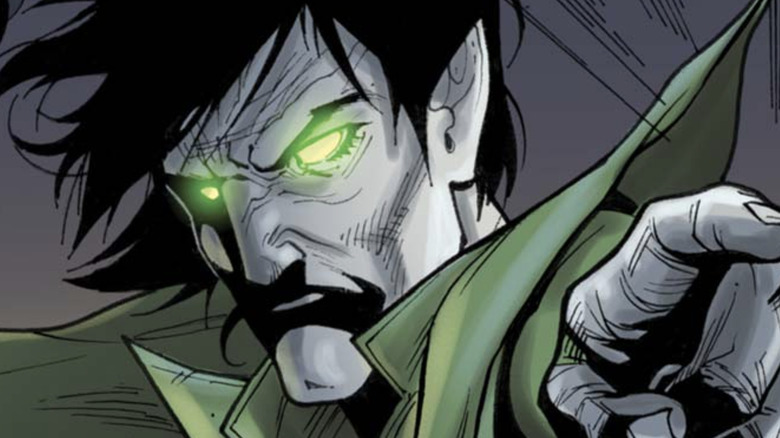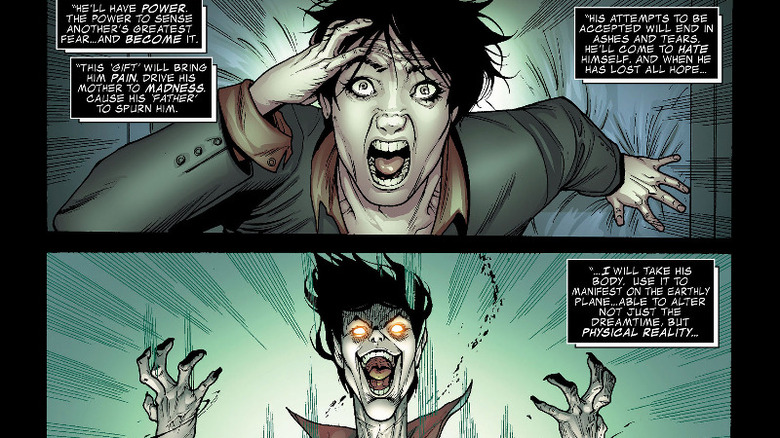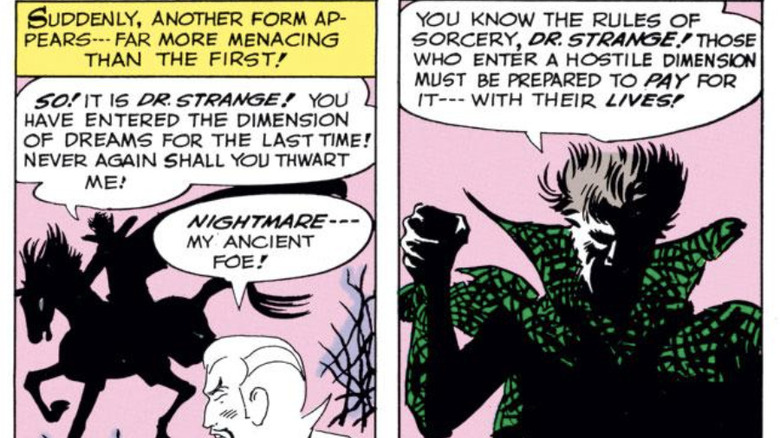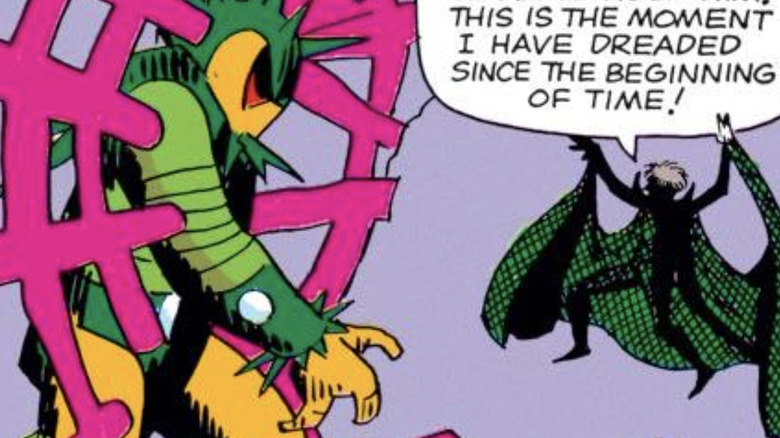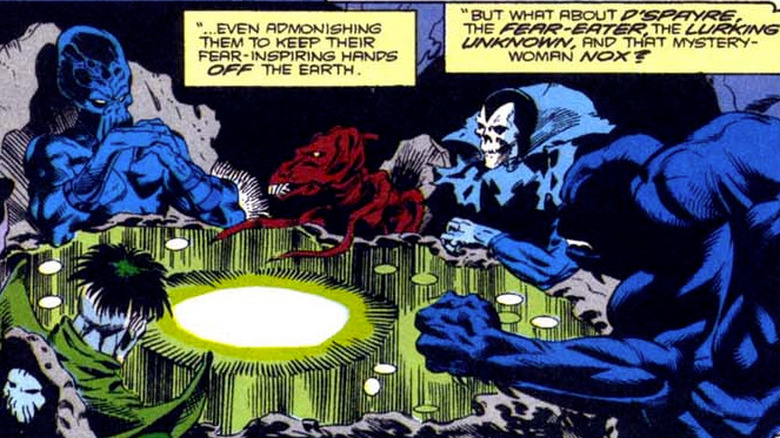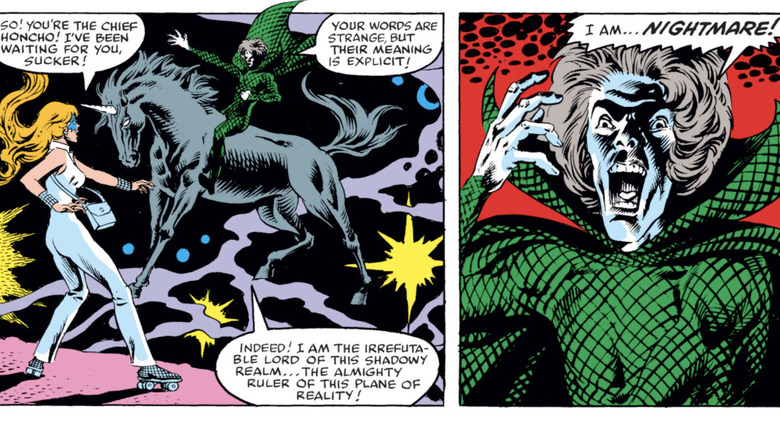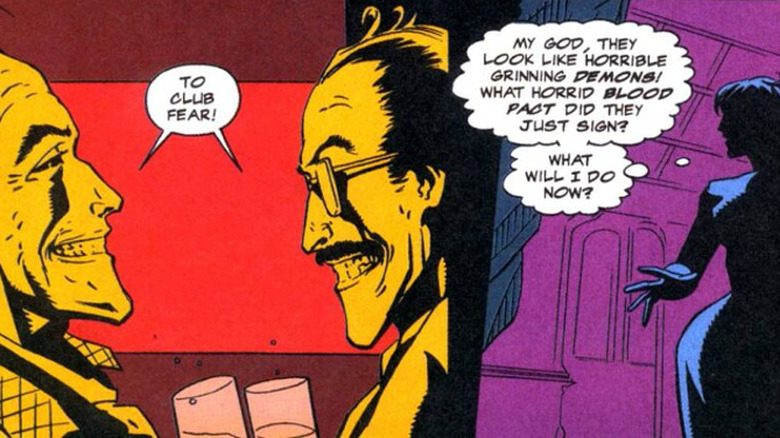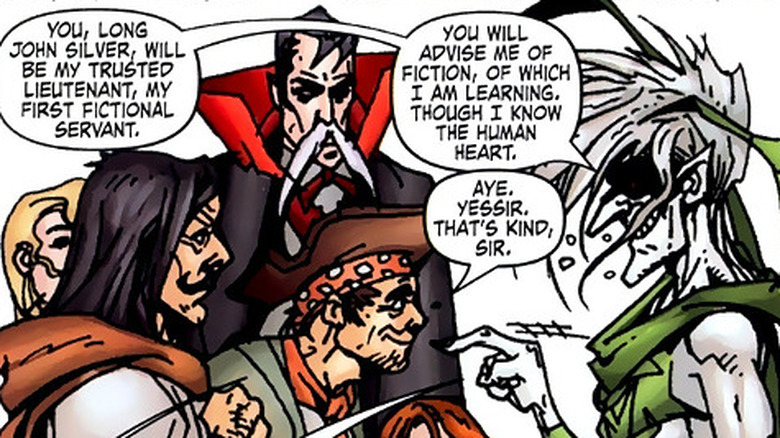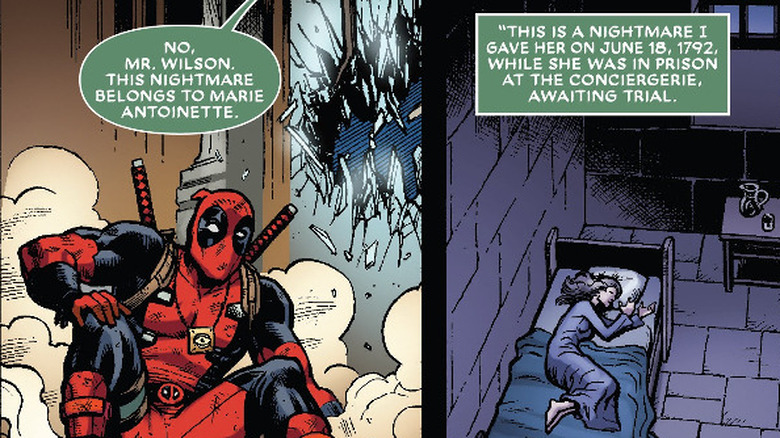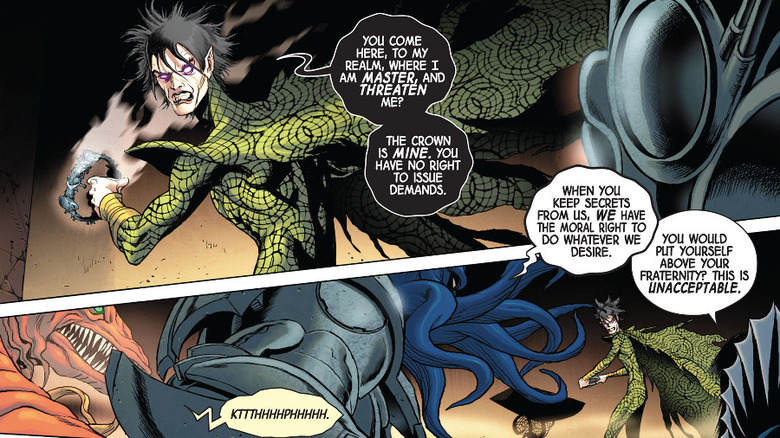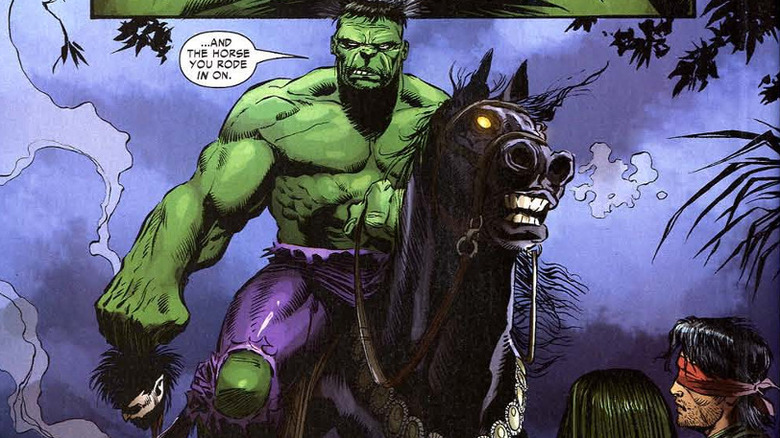The Untold Truth Of Marvel's Nightmare
Nightmare is one of the oldest figures in the entire Marvel Universe. Dating all the way back to 1963 (before the Avengers or the X-Men), he was Doctor Strange's first opponent, with both characters debuting in the pages of "Strange Tales" #110. The embodiment of dreams and the fear that fuels human nightmares, he's gone up against many Marvel characters over the years, though Strange remains his most resolute enemy. While not quite as dramatic in presentation as fellow Strange villains Baron Mordo or the dread Dormammu, Nightmare has always proven to be an extreme annoyance at the very least and a true menace to reality at his most terrifying.
Nightmare's origins were kept deliberately vague for a long time, but it was eventually revealed that he's part demon and part abstract representation, and that he spawned several children. He's been part of vast, powerful groups of fellow demons engaged in grand schemes, but he's also taken the time to haunt the dreams of fairly insignificant people. He's been killed more than once, but it never quite seems to take, and in a Marvel Cinematic Universe with an exploding multiverse, he seems poised to break out in a big way. Let's poke around Nightmare's weird past and shed some light on some of the stranger things that we find!
Proud papa
Nightmare isn't exactly father of the millennium, but he still interacts with (or annoys) his three children from time to time. His first was Dreamqueen, born after Nightmare forced himself upon a succubus named Zhilla Char. Zhilla died in childbirth, but Dreamqueen retained all of her mother's memories and realized she could bend reality to her whims in her own realm. She got bored, however, and started messing with First Nations people in Canada in an effort to come to Earth. She later terrorized Alpha Flight, kidnapping the team into her own dimension.
Working through a mortal named Karl, Nightmare later impregnated a woman named Naomi. Upon understanding what Nightmare was, however, she fled and married a man named Jerry Ward, and they raised her son Terrance together. This, however, was all part of Nightmare's plan. Terrance grew up with the power to transform into someone's worst fear and eventually joined the Avengers Initiative as a counselor, helping super-powered people cope with their abilities. While Nightmare eventually possessed him, Terrance (now known as Trauma) was freed thanks to his patient, Penance.
In an effort to gain revenge on the Hulk, Nightmare fathered Daydream by impregnating Betty Ross in one of her dreams. He then used Daydream to lure the Hulk into a series of illusions and nightmares. Daydream, however, turned against her father and went on to live "happily ever after." Aside from one brief appearance in the Nightmare Realm, she hasn't been seen since.
If you or anyone you know has been a victim of sexual assault, help is available. Visit the Rape, Abuse & Incest National Network website or contact RAINN's National Helpline at 1-800-656-HOPE (4673).
Strange's first sparring partner
"Strange Tales" was originally a horror anthology series that evolved toward science fiction and eventually began incorporating superheroes. In 1963, it was largely a solo spotlight for Johnny "Human Torch" Storm, who was featured in the main story of "Strange Tales" #110 — Doctor Strange's first adventure was just a few pages long. Despite this, artist Steve Ditko and writer Stan Lee established a number of important elements in that first story: Strange's relationship with the Ancient One, his magic amulet, his astral form, and his home in Greenwich Village. In the story, he's approached by a man with horrifying nightmares. Strange vows to help him by entering his dreams, but quickly learns that his client is haunted by his own dark acts.
Amidst all of this, seen in just six panels, is the first appearance of Nightmare. It's implied that Strange had entered his realm before, and that doing so means you're fair game for murder. The Ancient One (here referred to simply as "Master") helps Strange open his amulet from afar, distracting Nightmare long enough for Strange to slip out of the dream dimension.
Nightmare was one of Strange's most persistent enemies for years, in part because the Dream Lord knew that defeating Strange was the key to establishing dominion over the waking world. Nightmare was often more of an annoyance than a threat, but he had big plots from time to time, like kidnapping the cosmic entity known as Eternity.
The Dream King's enemies
In addition to sleeping humans and superheroes, Nightmare has a number of natural and regional enemies. Chief among them is Dusk, ruler of the Realm of Madness. Its denizens are the Nightmare Realm's next door neighbors, and Nightmare hates them — it's more difficult for him to feed off humans driven into total madness.
Speaking of things Nightmare hates, at one point, he was forced to ask Doctor Strange for help to stop a soul shard from destroying humanity (and thus, himself, as he needs humanity to dream). Nightmare was so angry at having to ask a mortal for help that his own personal nightmare, Gnit, was created. Gnit wasn't at all powerful, but he was annoying, and Nightmare's efforts to silence him only caused a second Gnit to appear. Once the day was saved, however, Nightmare was able to rid himself of the irritating creatures.
On another occasion, Nightmare captured an exhausted Doctor Strange when he forgot to cast a protective spell over his sleep, stripping Strange of his powers. Nightmare had the Sorcerer Supreme dead to rights, but suddenly, Nightmare's greatest foe appeared: the Gulgol, a relentless monster whom Nightmare couldn't affect because it never slept. Strange claimed to have summoned it, and a panicked Nightmare begged Strange to stop it. Strange agreed, but only if Nightmare restored his powers. Nightmare had no choice, and a fully-powered Strange revealed that he had merely hypnotized Nightmare into believing the Gulgol had appeared!
Joining the Fear Lords
In the 1992 storyline "The Great Fear," the Dweller-in-Darkness calls together a group of villains who feed on fear — the Lurking Unknown, Kkallakku, the Straw Man (originally known as the Scarecrow), Nox, Nightmare, D'Spayre, and Nightmare — collectively known as the Fear Lords. When the Straw Man learned that the gathering planned to attack Earth, he told them Earth was off limits and left. Nonetheless, under the leadership of the Dweller, the Fear Lords worked to bring about something known as "the Great Fear."
Thanks to the Straw Man's warning and further strife within the ranks of the Fear Lords, Doctor Strange, along with his lover, Clea, and his extradimensional apprentice, Rintrah, was able to defeat the Lurking Horror, Kkallakku, and Nox. Unfortunately, this was all according to the Dweller's plan — he was using the lesser Fear Lords to stir up fear on Earth, then using Strange to get them out of the way. At that point, the Dweller betrayed Nightmare, invading the dream realm and leading to a war between the two demons.
It was D'Spayre who suggested a fear-raising contest between Nightmare and the Dweller to determine who would rule. This, it turned out, was the Great Fear, and while it raged, humanity became so battered by fear that they moved on to despair ... making D'Spayre the most powerful of the Fear Lords. Nightmare and the Dweller fled before his sudden might, leaving Strange to overcome the supercharged D'Spayre with the power of love.
Bedazzled
Nightmare is immensely powerful and nearly impossible to defeat in his own realm, except by beings who can tap into vast eldritch forces. However, he's not exactly a tenacious fighter. He prefers to taunt his opponents and paralyze them with fear, and when that doesn't work, he sometimes runs out of ideas. Perhaps his most laughable defeat was against the mutant Dazzler, early in her career as a disco singer.
Dazzler came about as part of an ill-fated deal between Marvel and Casablanca Records, but she eventually got her own solo series, in which writer Tom DeFalco thought it would be a good idea for her to fight insanely overpowered villains and have her somehow defeat them. In "Dazzler" #4, she had to deal with two of them — seeking to acquire a powerful artifact called a Merlin Stone, Doctor Doom kidnapped Dazzler and sent her to the Dream Dimension, where she encountered Nightmare.
Nightmare taunted Dazzler with illusions of her father berating her, after which she fought a negative version of herself. In the end, Nightmare, a powerful demon, meekly surrendered the Merlin Stone because he didn't like bright light. Doom brought Dazzler back, but she destroyed the Merlin Stone by using her powers to create a laser. Obviously everyone underestimated her, but it should be noted that this was a Dazzler with no training. Not exactly Nightmare's best day.
Club Fear
Nightmare got his own miniseries in 1994 — coincidentally, just as Neil Gaiman's classic "Sandman" series, which was also about the King of Dreams, was winding down over at DC Comics imprint Vertigo. "Nightmare" fell into the hands of Ann Nocenti, who has written some of the strangest superhero comics of all time and who crafted a story that saw Nightmare get bored feeding off the same cliched dreams of humanity. He left his realm in the hands of fawning servant Doggerel, became human, and lost most of his powers.
On Earth, Nightmare became obsessed with a horror actress named Roxanne and adopted the identity of the dashing Edvard Haberdash to seduce her. He also took an interest in her director, an occult-obsessed weirdo named Lucre, who was devoted to the idea that horror was so great because "fear sells." Unbeknownst to Nightmare, rebellious fear demons Phobia and Paranoia plotted against him, freeing a monstrous, baby-like creature called the Exile in order to unseat him. Meanwhile, Nightmare worked with some of Lucre's devices to create Club Fear, where willing participants were shown their worst fears.
Nightmare eventually returned to his realm to deal with the Exile (who turned out to be the unborn twin brother of Lucre). Afterward, he tried to terrorize Roxanne into staying with him as he ruled the Nightmare Realm from Earth — until, of course, Doctor Strange stepped in.
Conquering the world of fiction
Another miniseries, 2008's "Fantastic Four: True Story," saw Sue Richards realize that she was becoming frightened of books and reading. When the rest of her family began experiencing similar fears, Sue deduced that someone was executing a coordinated attack on fiction. That someone, of course, turned out to be Nightmare.
When an author named Stephen G. Diesner caught a fleeting vision of Nightmare himself, he wrote a fictionalized version of the supervillain, and when the book was published, the Dream Lord suddenly noticed something new. In his realm, between the neighboring minor kingdoms Coma and Anesthesia, a new kingdom had emerged: the Land of Fiction. Nightmare invaded it and realized he could directly conquer humanity after years of trying to cross over.
He was opposed, however, by the Fantastic Four. Teaming up with Dante Allegheri and the Dashwood sisters from "Sense and Sensibility," they were nearly defeated by Nightmare's pawns, which included Long John Silver, Dracula, and the Sheriff of Nottingham. But Reed Richards eventually realized that, because Diesner's novel had turned Nightmare into a fictional character, his story could be changed. Thanks to the power of fiction, Nightmare was defeated and his abstract counterpart, the essence of creativity known as Fountainhead, was restored to his rightful place.
Famous nightmares
Nightmare is as old as sentient life itself. As a result, he's haunted the dreams of everyone, including famous people. In 2019's "Deadpool Annual" #1, the titular assassin was been hired by an 8-year-old boy to "kill his nightmares." Deadpool stole Doctor Strange's Amulet of Agamotto in order to reach the Dream Realm (asking if they were going to be sued by Neil Gaiman) and encountered Nightmare in a dream belonging to Marie Antoinette, when she was awaiting trial before her execution. Nightmare then showed Deadpool a dream he sent to Abraham Lincoln every day, of young men being sent to their graves, in order to fan his guilt.
Nightmare also occasionally tried to torment future super heroes. One example was Peter Parker, whose childhood love of monster comics was exploited by Nightmare — he and Uncle Ben fell asleep while fishing and were attacked by monsters in their dreams. Nightmare was delighted by the quality of Peter's dream energy and planned to use him as a victim for years, but he was beaten senseless by none other than Stan Lee himself!
The Fear Crown
When waves of fear washed over the Earth in the aftermath of the 2011 "Fear Itself" event, Nightmare plotted to collect that fear energy from sleepers in order to create the Fear Crown. This would allow him to wield fear more directly on the material world and finally let him conquer it. Loki (currently incarnated as "Kid Loki") was one of those who had fear energy, and he eventually gave it up to Nightmare so that other innocents wouldn't be hurt.
That energy was enough for Nightmare to create the Fear Crown. Before he could do anything else, however, he was confronted by the rest of the Fear Lords, who Kid Loki had tipped off. While Nightmare was stronger than any of them thanks to the Crown, he wasn't stronger than all of them put together. Kid Loki's machinations trapped the Fear Lords in a perpetual deadlock, each stealing the Crown in turn, only for everyone else to gang up on them and allow the Crown to be claimed by another.
The Fear Crown, however, played a key role in restoring the older version of Loki, who had secretly arranged for Mephisto to take it from the warring Fear Lords, making him one of the most powerful beings in the multiverse. As the Crown was made of Kid Loki's fears, he was forced to destroy it by ceasing to be, allowing the original Loki to return and ending Kieron Gillan's critically-acclaimed run on "Journey into Mystery."
The many deaths of Nightmare
Nightmare is an embodiment of fear, making him part actual demon and part conceptual being. As such, he's really, really hard to kill. But that doesn't mean it hasn't happened. The Hulk reacted to the story of Daydream's conception by ripping off Nightmare's head, which killed him for a while. A few years after that, Nightmare's death at the hands of Amatsu-Mikaboshi, God of Chaos and offshoot of the cosmic entity called Oblivion, was the inciting incident of the "Chaos War" storyline.
Much later, when Loki became the ruler of Jotunheim and promptly went to Earth to party, Nightmare saw an opportunity. If he could take over a realm with no ruler, it could give him the opportunity to conquer the rest of the Nine Realms of Asgard. Loki came back, however, used the Norn Stones to create a giant snowman named Frosti, and then had Frosti devour Nightmare.
A furious Nightmare returned and tried to trap Loki in his worst fear, but it turned out Loki's worst fear was being a ruler and getting everything he wanted — in other words, his real life. Loki then proposed that he and Nightmare fight a duel and that to make it interesting, they would both be mortal. When the duel began, Loki promptly summoned a flying car with his phone and used it to flatten Nightmare, who, being a brand-new mortal soul that had committed no sins, received a demon's ultimate punishment.
He went to Heaven.
